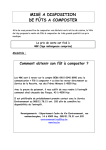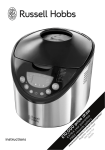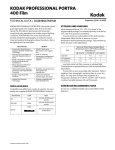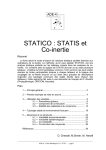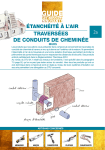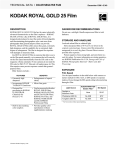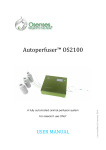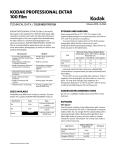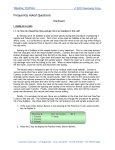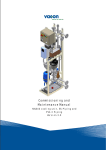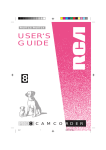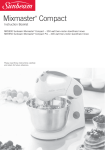Download USER MANUAL
Transcript
USER MANUAL MILKTESTER EMT KTPL 16-06-2011 Contents Page 1. Introduction 1 2. Technical Specification 2 3. Measurement Principle 3 4. Identification of controls and Connections 4-5 5. Diluent Preparation 6 6. Installation 6-7 7. Milk Sample Preparation 8 8. Operation 8-11 9. Repeatability 12 10. Calibration 12-13 11. Use Hints of Operation 14 12. Useful Hints on Preventive Maintenance 15-16 13. Spare Parts Identification 17-20 1. INTRODUCTION 1.1 One of the major objectives in the Dairy Development Programme is to increase the production of milk; Milk collection depended on prompt payment of fair and correct price to encourage producers to increase milk production. The system of payment based on quality (i. e, fat content) discourages adulteration and encourages producers to increase production of high quality milk. It is further very necessary that each sample of milk should be tasted for its quality and resting should be competed within 2 to 3 hours time in order to make correct payment, Milk sample would also get spoiled if not tested immediately in the absence of facility to preserve them, specially at village level. Age-old traditional ‘GERBER’ method of tasting milk by chemicals has many inherent drawbacks, such as; human error, multi step method, handling of corrosive chemicals and different types of glassware, All these add to the cost and time of milk testing. A quicker reliable and economical method of milk fat testing has therefore become inevitable and an immediate problem to solve. In the light of some of problems faced by ‘GERBER’ method of testing, it was felt prudent, to evolve a systems which should solve these problems. Milko tester (MT) is sample, economical but accurate milk fat testing instrument it measures the fat content instantaneously on a digital readout. It does not involve the use of corrosive chemicals. It works on light scattering principal with manual homogenization. It operates on AC-Mains as well as on /battery with inbuilt battery charge & automatic switch over to battery in case of power failure. This technical Manual of Milko Tester highlights the Basic principal involved, Diluent preparation, Key to controls & connections, installation & Operating instructions. The calibration and fault location have been very clearly described. The useful hints on Operation and Preventive maintenance have been specifically detailed along with suitable diagrames to benefit the user. 2. TECHNICAL SPECIFICATION Measuring range Upto 13% Fat Capacity 120-150 Sample per hour Accuracy 0-5% Fat: 0.06% 5-8% Fat: 0.04% 8-13% Fat: 0.20% Repeatability (Sd) 0-5 Fat: 0.03% 5-8% Fat: 0.04% 8-13% Fat: 0.08% Sample Volume 0.5 ml/test Diluent Volume 6.5 ml/test Calibration One Calibration Channel, adjustable within the range 0-13% Power Supply AC: 220/240V, Max. +10%, Min. -15% DC: 12V, Car battery, A full charged 120 AH battery will last for at least 10 hours operation. Ambient temperature 5-450C Dimension (H x W x D) 23 x 31 cm Weight (Without diluent) 16 Kg 3. MEASUREMENT PRINCIPLE 3.1 Milko Tester is based on the photometric measurement of light scattered by the milk sample. The light is scattered by the fat globules, acting as small prisms. 3.2 Not only fat globules in the milk contribute to the light scattering, but also the proteins may effect the measurement. To eliminate their influence, it is necessary to dissolve them; EDTA (Ethylene Diamine Tetra Acetic acid) solution is used for the purpose. 3.3 All the fat globules do not have the same size. The measuring system requires a constant globule size to provide a fixed relation between the amount if light scattered to the fat content, the range of globule size is limited in the Milko Tester to a very narrow region outside the natural range, This is achieved by homogenizing and bringing the globule size into the range of 0.5 to 1.5 microns. 3.4 Light rays from a photolamp pass through the layer of fluid in the cuvette and are scattered according to fat globules in the sample. More the fat present in the cuvette, more is the light scattered and less light passes through the cuvette. The rays that do pass through the cuvette hits the photocell, producing a current proportional to the light intensity. The current is fed to a digital readout unit which gives direct readout of Fat % in milk. 3.5 For better understanding of principal of measurement, photometer and its associated parts are described below. 3.5.1 Photometer: the Photometer consists of a lamp housing and detector assembly. The detector assembly includes the cuvette and photocell. 3.5.2 Cuvette: It is made of two hardened glass discs, One has a ground depression of 0.4 mm., the other has two small holder to provide inlet and outlet to the cuvette. 3.5.3 Photocell: It is silicon detector photocell. Care should be taken not to expose this photocell to light when not in operation. 3.5.4 Lamp: 12 Volts tungsten Lamp. 4. 4.1 IDENTIFICATION OF CONTROLS AND CONNECTIONS Front View 1. MILK IN Button 2. MIX OUT Button 3. ZERO setting knob 4. REPEAT button 5. Milk intake tube 6. Mix intake tube 7. Intake valve 8. Screw for bleeding pump 9. Diluent syringe windows 10. Milk syringe windows 11. Pump handle 12. Display 4.2 REAR VIEW 12. Mains ON/OFF switch (does not switch off battery) 13. MAINS socket 14. Inlet stub for diluent 15. Outlet stub for waste 16. Mains fuse (1A for 220/240 V) 17. Battery fuse (10A) 18. Heat Sink 19. 12 V battery socket 20. Switch for selecting type of power supply LINE – The MT operates on AC MAINS only. LINE/BATTERY – The MT Operates on AC MAINS/BATTERY and the battery takes over in the event of AC MAINS failure. CHARGE Switches OFF the Power supply from battery to MT and the battery gets charged if MAINS ON/OFF switch in ON. The MT cannot be operated if the switch is in this mode. 5. DILUENT PREPARATION 6.1 Diluents are used to dilute the milk sample and dissolve and dissolve the proteins. 6.2 Chemicals required to prepare 10 liters of diluent are as follow: (i) EDTA Sachet : 52.6 gms., containing; : 45.0 gms. of EDTA powder and 7.6 gms. of Di – Sodium hydroxide (ii) Trifon – X – 100 : (Emulsifier (iii) Antifoam : 6.3 6.4 6. 0.5 ml. 1.0 ml Procedure: Take a clean 10 Liters plastic container and add one liter clean water. Add contents of EDTA sachet, containing diluent powder for 10 liter solution. Add 0.5 ml. of Triton – X – 100 and 1.0 ml. of Antifoam. Put the lid on the container and shake it until all the chemicals are dissolved. Then add clean water until the contents are full 10 liters and shake again to mix the solution. The pH of this solution should be between 9.5 to 10.1 Diluent will remain good for 2 weeks before the Antifoam become inactive. Diluent can be kept longr if Antifoam is added to the solution from time to time (0.5 ml. for every 2 weeks). INSTALLATION 6.1 Place of installation should be such that there should be sufficient space for diluent container and Battery also Pump handle of Milko Tester must be easy to reach. 6.2 Check 1 Amp/ fuse in the Mains fuse-holder and 10 Amp. Fuse in the Battery fuseholder. 6.3 Connect power cables on mains. 6.4 Use only 12 V Car-battery. Connect RED lead of battery cable to ‘+’ of battery and BLACK lead to ‘-‘pole. Connect other end of the cable to Milko Tester. Figure 3, INSTALLATION 6.5 Set selector switch at LINE/BATTERY and mains switch at Mains switch at ON. Power will now be supplied to MT from battery. As long as mains switch is at ON position, current from Mains will keep the battery charged, if the power fails, battery will still be able to supply enough current for several hours of operation. Set the selector switch at LINE, if for any reason, the MT is to be operated on mains current without a battery. 6.6 Prepare the diluent in the container as described earlier in chapter 5. 6.7 Connect one end of the plastic pipe o the INLRT stub at the back of MT and attach the Filter Unit to the other end which is then placed in the diluent container. 6.8 Connect one end of the plastic pipe to the OUTLET stub and place the other end in the waste container. 6.9 7. Place empty beaker under milk intake tube and push ‘MILK IN’ and ‘MIX OUT’ buttons alternately until no bubbles are seen in syringes, End by pushing ‘MIX OUT’ button. MILK SAMPLE PREPARATION 7.1 Sampling : The samples measured should be taken from milk in good condition, i.e. the milk should not have started to curdle or separate, and it should be free of dirt. Since milk fat is of lower density than the other milk constituents, therefore it tends to rise to the surface. Gently stir the bulk milk just before sampling to make sure that sample is a true representative of the bulk. Fresh unpreserved sample must be tested immediately just before testing, turn the sample upside downs a few times to mix it properly. 7.2 Preservation : If measurement can not be made immediately after sampling, then samples can be preserved for maximum 12 hours, without refrigeration, by adding 1 ml saturated Potassium Dichromate solution in 100 ml. milk. If they are to be kept longer for measurement and if transportation is necessary, then cool the preserved sample to 5-10oC but never freeze them. Samples which have been cooled will be easy to mix if they are warmed upto 30-40oC before being measured. 8. OPERATION: 8.1 Warm up: If the Milko Tester has been switched-off, then it must be allowed to warm-up before starting measurement. This is done by just switching on the MT, half an hour to one hour before measurement. 8.2 De-airing Syringes: The flow system must be free of air bubbles to ensure proper measurement. Presence of any air bubble in the syringes must be removed as follows: Place an empty mix beaker under milk intake tube and push 'MILKIN' & 'MIX OUT' buttons alternately until no air bubbles are seen in the syringes. End by pushing 'MIX OUT' button. 8.3 Zero Check: The ZERO setting button is used to set the readout to 0.00when the cuvette contains pure diluent. Zero check described below should be carried out daily before starting measurement and then once every half hour for the first 2 hours and then once an hour. Press REPEAT button to get second decimal on the display. Place the clean empty mix beaker under the milk intake tube and press 'MILKIN & MIX OUT' buttons twice alternately to fill the mix beaker with diluent. Move the mix beaker to the mix intake tube and operate the handle six times up and down. The display would be around 0.20 in any case this reading should be less then 0.40 Repeat the above operation two times more to ensure the reading remains same and less than 0.40. Push the Zero button to set the readout to 0.00 after Zero setting press the REPEAT button to get one decimal readout. Note : Once every half hour for the first 2 hours and then once every hour, momentarily put OFF the MT and put if ON again. (The display should read 0.20+ with diluent in the cuvette.) 1. PREPARATION (i) Set power Switch at ON (ii) Set battery Switch at LINE/BATT (iii) Fill bottle with diluent (iv) Empty waste bucket (v) Do not start procedure 3 until MT has been switched on for at least half an hour. 2. BLEEDING SYRINGES (i) Place a cup under milk intake (ii) MIX OUT Push MILK IN button and them button. Repeat 6 times or until systems is free of air bubbles 3. SETTING DISPLAY AT (i) Place mix beaker under milk (ii) Push MILK IN, MIX OUT, MILK (iii) (iv) MIX OUT. Move mix beaker to mix intake. Raise and lower handles 6 (v) Push, REPEAT button so display 0.00 intake. IN and times. blinks. (vi) reads 0.00 (Seconds decimal) Push ZERO button so display (0.00) (vii) Push REPEAT so display doesn’t blink. (one decimal) Figure – 4, OPERATION 8.4 Measurement : After de-airing and Zero Setting, measurement can begin. First result after Zero check/Zero setting should not be recorded as it will be little low. Therefore, measure the first sample after Xero check twice and record only second result Turn the milk sample gently upside down, a few times. Place the sample under milk intake and fully press 'MILK IN'[ Button. Slowly remove the sample without touching the milk intake tube. Place clean mix beaker under milk intake so that if fits into the notch on the side of the MT. Press 'MIX OUT' button in all the way, to dispense milk and diluent into the mix beaker. Move the mix beaker to the mix intake tube and position. It, so that if rests in the Notch. Operate the homogenizer handle up & down three times in a steady movement. When the handle is pressed down the third time, let it rest in bottom position & result will soon appear on the display. Empty the mix beaker completely and it is ready for the next sample. 8.5 End of Measurement : Place a clean, empty mix beaker under milk intake tube & press 'MILK IN & MIX OUT' buttons twice alternately to fill mix beaker with diluent place the mix beaker under mix intake & operate the handle up and down six times to flush the cuvette. Switch-of the EMT. 8.6 Deairing the Homogenizer : Air will enter the homogenizer if the handle is raised when there is no liquid present at the mix intake tube. Place the mix beaker under milk intake tube & press ' MILK IN & MIX OUT' buttons twice to fill the beaker with diluent. Raise the handle. Loosen the Bleeder Screw on the top of mix intake valve. Let the handle drop by its own weight and tighten the Bleeder Screw again. Operate the handle three more times, up and down, to be sure that all air is out of the system. 8.7 Electronic check : Refer Section 12.2.8 1. (i) (ii) (iii) MILK IN Gently mix milk sample Place sample under milk intake. Push MILK-IN button. 2. (i) MIX OUT Empty mix beaker (ii) Place mix beaker under milk intake (iii) Push MIX-OUT button 3. (i) (ii) PUMP Move mix beaker to mix intake Raise and lower handle 3 times 4. (i) READ Read % fat on display and record. Figure – 5, MEASUREMENT 9. REPEATABILITY 9.1 A Check for repeatability is a simple way of making sure that the instrument is in proper working order, as leaks and poor connection will affect the repeatability. 9.2 Take a large, well-mixed sample and measure it repeatedly, Press the Repeat Button to set two decimal place on display. Note down the result and make up table like the example given below. (The result of the first measurement s not recorded) Result No. Result 1. Divination from the average (d) 6.40 +0.03 6.44 +0.01 6.42 -0.01 6.45 +0.02 6.44 +0.01 6.44 +0.01 6.42 -0.01 6.43 0.00 6.42 -0.01 6.44 +0.01 d2 0.0009 2. 0.0001 3. 0.0001 4. 0.0004 5. 0.0001 6. 0.0001 7. 0.0001 8. 0.0000 9. 0.0001 10. 0.0001 (i) 0.002 Add Result (i) Average = 6.43 (ii) Sd = = 64.30 ± £d2 = £d2 N-1 Where; n = No of reading i. e. : 9 d2 = square of deviation for average 0.0002 9 (iii) 10. == 0.014 Compare the Sd with the specified limits preserved earlier CALIBRATION 10.1 The purpose of calibration is to adjust the instrument of give result over the whole measuring range. There are 2 step in calibration, one to give a correct linearity and the over to give correct results when compared with the results of a reference method. 10.2 if the milk sample of different fat content are measured, one expects the instrument to show these results within some small limit. If all result are too high or too low by the same proportion, the linearity is all right. Then test the known high fat reference sample on MT and turn ADJUST SCREW (P3 on are too high or vice versa, then the linearity must be adjusted as follows; Take one sample of high fat content (Actual fat is of no importance,) Linearity: (i) Results of Half Value 1. 2. 3. 4. A Average (ii) Results of Full Value 1. 2. 3. 4. B Average (iii) B-2A = C (iv) C x (-3) = D (v) From B, adjust with CURVE SCREW (P2 on measure PBC) up or down by D, then adjust with ADJUST SCREW (P3 on measure PBC) down or up to give 2A. Full Value : Measure the sample in a normal way to get full value of the measurement. Half Value : Place empty mix beaker under milk intake and press ‘MILK IN’ & ‘MIX OUT’ button to fill the mix beaker (i) Place milk sample under milk intake tube and press; ‘MILK IN button. Place mix beaker under milk intake tube & press ‘MIX OUT’ button of dispense milk & diuent into the mix beaker (ii) Remove this mix beaker & Place mix beaker (i), containing only diluent, under milk intake and press ‘MILK IN’ button and remove this mix breaker. Place the mix beaker (ii) once more under milk intake tube & press ‘MIX OUT’ button. This will give double volume of diluent, so that result should be half of that obtained in the normal way 103 An example will simplify the procedure of linearity adjustment. 10.3.1 The average of half value = 4.61 The average of full value = 9.44 9.44-(2x4.61) i.e. 9.44 -9.22 = +0.22 This means, the high results are more than twice the low results, Multiply the difference by -3 (in this case, -3x0.22 = -0.66), With the small screw driver, turn the CURVE SCREW (P2) from 9.44 to 8.78 (9.44 -0.66=8.78) Then turn the corresponding ADJUST SCREW (P3) from 8.78 to 9.22 to get the correct valve. 10.3.2 If the high result are low, say 9.13, the comparison will give a negative number i. e. 9.13 –(2x4.61) =9.13-9.22=-0.09 Multiply the difference -3 [in this case, -3 (x)-0.09 = +0.27] Which means that CURVE SCREW (P2) Must be adjusted upwards instead of down wards and ADJUST (P3) Must be adjusted downwards to the correct value. 10.3.3 Continue the above procedure untill the difference ‘C’ is less than 0.04 11. USEFUL HINTS ON OPERATION 11.1 The instrument should be kept clean. 11.2 Half an hour to one hour warm up, de-airing syringes & check must not be forgotten before starting the measurement. 11.3 When pressing the 'MILK IN' & 'MIX OUT' buttons, use the ridge on the cabinet to support the fingers, and press the buttons, evenly with the thumb. This will improve your instrument's performance. 11.4 Chemicals must be stored in a clean & dry place. 11.5 It is not necessary to clean the milk intake tube and mix intake tube between each sample measurement. If the milk intake tube reaches far into the sample, it may be necessary to wipe it between sampling & dispensing to avoid carry over. This happens if milk from one sample is left on the outside of the milk intake tube and is then mixed with the next sample. 11.6 Place milk sample under the milk intake tube so that the tip of the tube is approximately 5 mm below the surface. Though 5 mm is not so critical but the tube should be dipped at the same distance below the surface in every sample. 11.7 During storms with lightening. unplug the MT from mains supply to avoid danger of damages to the instrument. 11.8 MT should preferably be connected with battery & normal position of operation is; Mains at ON and selector switch at LINE/BATTERY. If mains fails, battery will still be able to supply enough current for several hours of operation. If battery reserve is low, then set selector switch at CHARGE, with Mains at ON. This switches off power supply to measuring circuit, A completely drained battery will be fully charged in 8.12 hours. 11.9 Battery fuse will blow if leads are connected to wrong poles on the battery. Always remember to connect red lead of battery cable to "+ve" pole of 12V car battery and black lead to "1Ve" pole. 11.10 Check the acid level of the battery once a fortnight and refill it if necessary with distilled water until plates are just covered. 12. 12.1 USEFUL HINTS ON PREVENTIVE MAINTENANCE Milko Tester accurate results if; (i) It shows a stable 'Zero at 0.20(+0.03) upto an hour during the time milk is being tested (See sec. 8.3, OPERATION) (ii) It shows a stable read out (+0.03 after the third stroke when operated on second decimal. (iii) It shows essentially the same readout when the same sample is tested again & again. (iv) It has been calibrated by comparing its results with "GERBER" method. However, it may give misleading results if one or more of the above features fail. Therefore make a quick check every day at start up, and a compete check once a week. 12.2 The hints below will help you locate and remedy troubles, should they appear. 12.2.1 Display fails : If no display, the supply voltage from Battery or Mains probably has failed. Either of the fuses has burnt out. Use 10A fuse for battery and 1A fuse for mains. 10A fuse is intended to burn out if the battery's negative pole is connected to the MT positive terminal & vice versa. 12.2.2 Zero-setting fails : (i) First apply double measure of diluent to the mix intake and operate the handle six times. (ii) If only any one digit of the 4 digit display is glowing (Showing any number) which remains unaffected by 'ZERO' button but check 12.2.8 (i) is OK, the lamp is probably burnt out or the photocell is faulty. However, first check the supply voltage. Battery should be min. 10.5V, Mains minimum 190V. Check loose or broken connection to lamp or photocell. (iii) If above procedure fails to locate error or in case the reading show zero and can not be raised. then either photocell or lamp or Power PCB/Measure PCB is faulty. 12.2.3 Zero drifts : (i) The 'zero' drift means that 0.20 readout is not stable. Zero drift is normal during warm-up period because Thermo block temperature needs time to stabilize. (ii) If 'zero' continues to drift or fluctuate or 0.2_+0.03 can not be obtained after warm-up/Power ON, then check supply voltage. (iii) Zero drift may b caused by air intake. Therefore make sure that homogenizer pump is perfectly deaired and that the mix-in take tube is firmly fixed in the lowest possible position in the slot, otherwise the volume supplied by the syringes will not be sufficient to give an air free charge at the third pump stroke. (iv) Even if air intake is excluded, air bubble may appear in the cuvette (causing the readout to drifts slowly upscale after pump operation & goes back very slowly) if the valve V3 after cuvette outlet is leaking. A quick check for this is to raise the external waste tube to a position above the MT to increase cuvette pressure. If this stabilizes the readout, then clean Valve V 3. (v) If zero drifts quickly up-scale by about 03.-1% after pump operation & goes back slowly, then this may be due to the moisture or condensation on the outside of the cuvette glass, which must be carefully wiped dry. (vi) In rare cases, malfunctions of the photocell or lamp may cause Zero drift. 12.2.4 12.2.5 12.2.6 12.2.7 12.2.8 12.2.9 Readout drifts after a milk test: A slow down-scale by 0.01-0.04% considered normal & does not affect results on one decimal readout. If drift is more, then that is because of possible presence of moisture or leakage in the cuvette. There for cuvette may need new gaskets. It s a important that the inside of the photometer must be carefully wiped dry before assembly. This drift may also be caused by dirt in value V3, therefore lean the value V3 also. Repeatability fails : When the same sample is tested again and again it must show repeatability within the prescribed tolerance limit. If higher variation appear, check the following. Is the MT being operated correctly? (i) 'MILK IN' & MIX OUT' button should be pressed smoothly and uniformly. (ii) Dont' push 'MIX OUT' button so fast that mix splashed out of the mix beaker during the discharge. (iii) Never touch the milk intake tube when removing the sample bottle. Is the test sample in good condition? If it is acidified, churned out, separated or otherwise non-uniform, the good repeatability can not be obtained. Instrument checks : (i) Remove the connections from the photocell coming to the spades at the top of Measure PCB, only any one of the digits of the 4-digit display should glow (showing any number 0-9). Now short the spades with a piece of wire or tweezers/forceps, the display should read 00.00, then measure PCB is OK, otherwise it is faulty. (ii) Operate the MT with the diluent along (no milk), note that there is no zero drift. (iii) If zero is stable, the lamp cuvette & photocell are in good order and the trouble must be in the syringe assembly. The possible cause is leaking of valves V1, V2, V3 which will cause high & fluctuating results. Miscellaneous problems : (i) If it is difficult to suck mix from mix intake tube, then clean the ball of mix intake valve. (ii) If diluent leaks from milk intake tube, then clean valve V2. (iii) (iv) If fluid leaks from bleeder screw of mix intake valve, then replace gasket of bleeder screw. ] If flued leaks from mix intake valve when handle is pressed down, then replace the ball of intake valve. 13 PARE PARTS INDENTIFICATION 13.1 INTAKE VALUE Figure – 6, INTAKE VALUE Pos Part No. Item 1 171025 Spacer, Complete 5 172130 Seat, Complete 8 172148 O-ring 9 190306 Ball 10 184358 Screw, M3 X 15 11 183640 Screw 12 084517 O-ring 13.2 VALVE UNIT V1,V2,V3 Figure – 7, VALVE UNIT V1,V2,V3 Pos Part No. 1 205765 Valve body, Complete 6 9 191593 --191650 213660 191668 060749 192153 049254 148262 131557 121558 Valve body, Complete Spring, Not used in V1 Spring, V2 Spring, V3 O-ring Ball, V1 Ball, V2, V3 Wire Strap Code, red, V1 Code, green, V2 Code, blue, V3 10 11 12 13 Item 13.3 PUMP PISTON Figure – 8, PUMP PISTON Pos Part No. 1 244962 Item Piston rod. 2. 3. 4. 272088 171108 243857 Piston steel Support, ring O-ring HOMOGENIZER Figure – 9, HOMOGENIZER Pos Part No. 1 2 3 4 5 6 7 8 9 10 11 12 13 14 15 Item 179820 171074 023820 197509 244624 293571 007419 035832 195727 171009 054007 213249 333237 299506 011890 Intake, Value O-ring Seat Ruby ball Valve housing Distance piece Nut M6 Allen screw Screw, M4 X 16 Slide O-ring Guide Spring Spring housing Spring washer PHOTOMETER Figure – 10, PHOTOMETER Pos Part No. PCI 1 2 8 9 10 12 13 14 15 17 ` Item 041111 183111 183244 204727 209148 055442 171413 213488 042234 042242 207258 Photocell Block cp Cable, complete Bush Distance piece Gasket Diaphragm Gasket Cuvette glass Cover glass Holder complete 18 207233 Diaphragm
































